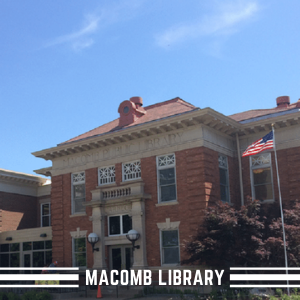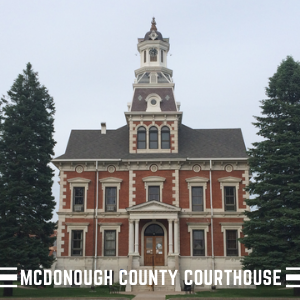Answers to Commonly Asked Questions concerning the City of Macomb’s Historic District or Landmark Designation Program
What does being designated a landmark or within a historic district mean?
Certain individual buildings and those within historic districts are considered to be important to the historical character and unique heritage of the city. Formal recognition enables the City to preserve, enhance and protect selected structures and districts with the intent of maintaining the uniqueness, history and charm of the community.
Why undertake historic designations and establish a local Commission?
Designation is the community’s way of identifying and recognizing individual structures and areas within the city that are significant for their styles, designs, features, and materials or their association with historical events or individuals. It is also the community’s way of designating certain historic properties and neighborhoods for eligibility for special financial incentives and development programs.
What has Macomb designated at this point?
Currently, the Macomb Historic Preservation Commission (HPC) is proposing a downtown historic district that includes the area bounded by Calhoun and the Amtrak Depot on the north; Washington and Jefferson Street on the south; McArthur St. on the west; and Campbell on the east. Once this has been accomplished, the HPC may be looking at neighborhood districts along S. Lafayette and S. Randolph Streets.
There are also a number of individual sites that could be considered in the future although none have been specifically named at this time. All designations are ultimately authorized by the City Council upon recommendation of the HPC. Any district designation requires the consent of at least 51% of the property owners within the district. Landmarks can be designated by the HPC with or without owner consent although that consent would certainly be sought out.
How do citizens go about having a structure or district considered for designation?
Applications for both landmark and district designation are available through the City of Macomb Office of Building & Zoning. Each application asks for specific information concerning the structure or district’s uniqueness, historic or architectural significance, association with past events, persons, cultural periods and any distinct location or physical features. The Historic Preservation Commission will, following the holding of a public hearing and application review, make a recommendation for designation or denial to the City Council. The entire process from application submission to a final decision should take not more than 45-60 days.
What are the overall benefits of these designations to the community as a whole?
Some intangible benefits are community pride, preservation of local history, and establishing a “sense of place”. Other, more measurable affects are increased property values, increased customer activity and sales in commercial areas, enhanced tourism and marketing opportunities. Furthermore, it guarantees a level of protection of sites that contribute to the heritage of the city.
What resources, including financial, may be available for individual property owners?
> Property owners of individual commercial landmarks and those within districts may be eligible, with State consent, to make use of the Federal Tax Credit program for direct credit of federal taxes of up to 20% of improvement costs.
> The Property Tax Assessment Freeze program, available primarily for owner-occupied residences, is a program for those structures achieving landmark designation individually or within a recognized district (with State consent).
> The City will, on behalf of individual property owners, request basically unlimited free technical rehabilitation, architectural, design, and concept assistance from staff members of the Illinois State Historic Preservation Agency. Staff members are well versed in the process of preserving and tastefully remodeling historic buildings. Their advice is non-binding but is certainly recommended.
> The IRS may offer a 10% rehabilitation tax credit for buildings built prior to 1936 (regardless of historic standing). There may also be a 50% tax credit for renovations to commercial buildings for access to the physically disabled. The current status of both of these programs should be verified through the IRS web site at www.irs.gov., “forms and publications” link.
> Low-interest loans for building rehabilitation are available to qualified applicants through a program administered by the City’s Office of Building & Zoning.
What are my responsibilities as property owner of a landmark or within a historic district?
If you, as the owner, want to make any changes to the exterior of your property that would require a building permit or significantly alter the appearance, you will need to obtain a Certificate of Appropriateness (COA) from the City and Historic Preservation Commission prior to beginning work. The exterior work you propose will need to comply with a set of historic rehabilitation standards aimed at preserving the heritage and character of the building. While these standards are requirements, the Macomb Historic Preservation Commission believes that most are logical and based on common sense and sound construction practices and therefore should not be difficult for most persons to comply with.
Tenants or leaseholders can also submit applications for COAs but must have the written consent or sign-off of the property owner to do so.
What is a Certificate of Appropriateness?
The Certificate of Appropriateness (COA) is a document issued by the Macomb Historic Preservation Commission that documents that the exterior work planned for a historical structure or site is fitting to its historic nature, character, and architecture and also fitting to its context and appearance within a particular block or a historical district. The COA needs to be obtained in conjunction with a regular building permit. There is no charge for the COA.
What changes to a building require a COA?
A COA is required when construction, alteration, removal, or demolition requiring a building permit is proposed to the exterior of any designated landmark or structure within a historic district, and/or when any changes affect the character of the significant features of these structures.
How do I get a COA?
An application, available at the City’s Office of Building & Zoning needs to be completed and reviewed by the City staff and the Macomb Historic Preservation Commission. Additional documentation may be necessary to facilitate the review process. There is no fee for the COA application. Normally, if complete applications and attachments are submitted, they can be reviewed and decided upon within twenty (20) days of submittal.
Can decisions of the Commission on COAs be appealed?
Yes, if an applicant feels that the decision rendered by the Macomb Historic Commission was incorrect, unfair, or improper, an appeal can be made to the City Council which has the final say. Likewise, appeals can be made on grounds of economic hardship in a case where an applicant can not afford to make repairs in accordance with adopted guidelines.
Will I have to restore or repair my building if it is historically designated?
Absolutely not. The designation of a landmark or a historic district does not mean that you have to restore your building. It means that if and when you need or decide to make changes, they need to be consistent with the overall historical and architectural character of the designated building or the district as a whole.
Will my changes or repairs cost more if my property is a landmark or is located in a historic district than if it wasn’t?
Not necessarily. Historic preservation guidelines allow for a wide range of rehabilitation options – from complete restoration to basic maintenance. In many cases, repairing existing features may be less expensive than replacing them with new features. This also preserves the historic materials of the property. Expert assistance on cost-saving techniques is available from the State of Illinois Historic Preservation Agency.
What are the guidelines used to determine what changes are proper to the exterior of landmarks or structures within historic districts?
The guidelines used are those as set forth in the Macomb Historic Preservation Ordinance and supplemented by the “Secretary of the Interior Standards for Rehabilitation”. They serve as a guide and resource to property owners, architects, contractors, the HPC, and the City staff during the process of reviewing exterior changes to properties. Specific or detailed information on any aspect of the standards can be provided to anyone undertaking a project upon request.
Can I add on to an existing historic building?
Yes. Additions can be made to historic buildings if they are compatible and/or complementary to the architectural character of the original building, and meet all zoning requirements of lot coverage and setbacks.
Can I install a ramp to make my property accessible?
Yes. Ramps for disabled accessibility, considered additions to historic buildings, can be installed to historic buildings. They can be constructed without affecting the character of the structure.
Will I have to hire professionals to work on my historic building instead of doing the work myself?
Not necessarily. Many maintenance projects are completed by the property owners themselves. For projects where a building permit is required, you may be required to submit drawings and specifications. This is required whether or not the structure is a designated landmark or located in a historic district.
For more information on any of the topics listed above, please contact John Bannon, Community Development Coordinator at the City of Macomb Office of Building & Zoning, 309-833-4944 (p) or via E-mail at jbannon@cityofmacomb.com
__________________________________________________________________________________________________________
GLOSSARY OF COMMONLY USED TERMS IN HISTORIC PRESERVATION
1. Alteration – Any act or process that changes one or more of the exterior architectural features of a structure, including, but not limited to the erection, construction, remodeling, reconstruction, or removal of any structure.
2. Addition – Any act or process which changes one or more of the “exterior architectural features” of a structure designated for preservation by adding to, joining with, or increasing the size or capacity of the structure.
3. Building – Any structure created for the support, shelter, or enclosure of persons, animals, or property of any kind and which is permanently affixed to the ground.
4. Certificate of Appropriateness – A certificate from the Macomb Historic Preservation Commission authorizing plans for alterations, construction, remodeling, removal, or demolition of a landmark or site within a designated historic district.
5. Commission – Macomb Historic Preservation Commission
6. Construction – The act of adding an addition to an existing structure or the erection of a new principal or accessory structure on a lot or property.
7. Council – The City Council of the City of Macomb.
8. Demolition – Any act or process that destroys in part or in whole a landmark or site within a historic district.
9. Design Guideline – A standard of appropriate activity that will preserve the historic and architectural character of a structure or area.
10. Exterior Architectural Appearance – The architectural and general composition of the exterior of a structure, including, but not limited to the kind, general color scheme, and the texture of the building material and the type, design, and character of all windows, doors, light fixtures, signs, and appurtenant elements.
11. Historic District – An area designated as a “historic district” by ordinance of the City Council and which may contain within definable geographic boundaries one or more landmarks and which may have within its boundaries other properties or structures that, while not of such historic and/or architectural significance to be designated as landmarks, nevertheless contribute to the overall visual characteristics of the landmark or landmarks located within the historic district.
12. Landmark – Any building, structure, or site which has been designated as a “landmark” by ordinance of the City Council, pursuant to procedures prescribed herein, that is worthy of rehabilitation, restoration, and preservation because of its historic and/or architectural significance to the City of Macomb.
13. Owner of Record – The person, corporation, or other legal entity listed as the owner on the records of the County Recorder of Deeds.
14. Rehabilitation – The process of returning a property to a state of utility, through repair or alteration, which makes possible an efficient contemporary use while preserving those portions and features of the property which are significant to its historic, architectural, and cultural values.
15. Removal – Any relocation of a structure on its site or to another site.
16. Repair – Any change that does not require a building permit or that is not construction, relocation, or alteration.
17. Structure – Anything constructed or erected, the use of which requires permanent location on or in the ground, including, but not limited to, decks, fences, gazebos, advertising signs, billboards, and any commercial or residential accessory buildings.
18. Structural Change – Any change or repair in the supporting members of a building, structure, roof, or exterior walls that would expand the building in height, width, or bulk of the building.











